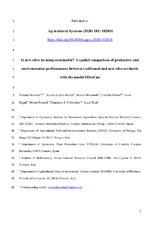Mostrar el registro sencillo del ítem
Is new olive farming sustainable? A spatial comparison of productive and environmental performances between traditional and new olive orchards with the model OliveCan
| dc.contributor.author | Mairech, Hanene | |
| dc.contributor.author | López Bernal, Álvaro | |
| dc.contributor.author | Moriondo, Marco | |
| dc.contributor.author | Dibari, Camilla | |
| dc.contributor.author | Regni, Luca | |
| dc.contributor.author | Proietti, Primo | |
| dc.contributor.author | Villalobos, Francisco J. | |
| dc.contributor.author | Testi, Luca | |
| dc.date.accessioned | 2022-01-25T12:33:14Z | |
| dc.date.available | 2022-01-25T12:33:14Z | |
| dc.date.issued | 2020 | |
| dc.identifier.uri | http://hdl.handle.net/10396/22388 | |
| dc.description.abstract | Olive (Olea europaea L.) is a widely spread tree species in the Mediterranean. In the last decades, olive farming has known major management changes with high economic and environmental impacts. The fast track expansion of this modern olive farming in these recent years casts doubts on the sustainability of such important tree plantation across the Mediterranean. In this work, we performed a spatial modelling analysis to investigate the implications of climate variability and farming management on the productivity and environmental performances of olive orchards around the Mediterranean. Implementation of this research is based on the use of OliveCan; a process-based model able to illustrate responses of water and carbon balances to weather variables, soil characteristics and management techniques enabling the comprehension of olive orchard dynamics under heterogeneous conditions of climate and agricultural practices. Four main intensification levels were adopted to reflect the main olive grove types from traditional to new intensive plantations: low density LD (100 trees ha−1), medium density MD (200 trees ha−1), high density HD (400 trees ha−1) and super high density SHD (1650 trees ha−1). Managements tested were intensification, water supply (rainfed, deficit and full irrigated) and the fate of pruning residues (exported or left on the soil). Two cases studies in two of the main Mediterranean olive-growing regions with contrasting environmental conditions, Tuscany and Jaen regions, focused on mitigation alternative managements for carbon sequestration. Results showed that olive orchards responses in terms of yield and Net Ecosystem Productivity (NEP) vary along with climatic conditions. Water supply was the main driver with a production function that varies for different atmospheric demands. Application of deficit irrigation proved to boost water use efficiency. Besides, intensification from LD to SHD, presented the greatest improvements, 28–73% for yield and 50–100% for NEP. The C sequestration potential of olive orchards was confirmed. In fact, soil organic carbon (SOC) increased continuously over 400 years of simulation, reaching a state of equilibrium. Moreover, intensification and irrigation improved total carbon sequestration. Management of incorporating pruning residues in the soil increased SOC of 10.5 t C ha−1 for Tuscany and 10.8 t C ha−1 for Jaen. Findings of this research enabled the identification of the main drivers influencing the productive and environmental performance of olive groves in the different Mediterranean sub-climates. Impacts of management innovations on olive farming sustainability were also quantified which may help improve production systems for a more sustainable olive cultivation. | es_ES |
| dc.format.mimetype | application/pdf | es_ES |
| dc.language.iso | eng | es_ES |
| dc.publisher | Elsevier | es_ES |
| dc.rights | https://creativecommons.org/licenses/by-nc-nd/4.0/ | es_ES |
| dc.source | Agricultural Systems 181, 10281 (2020) | es_ES |
| dc.subject | Olea europaea | es_ES |
| dc.subject | Climate | es_ES |
| dc.subject | Agricultural management | es_ES |
| dc.subject | OliveCan | es_ES |
| dc.subject | Carbon sequestration | es_ES |
| dc.subject | Mitigation | es_ES |
| dc.title | Is new olive farming sustainable? A spatial comparison of productive and environmental performances between traditional and new olive orchards with the model OliveCan | es_ES |
| dc.type | info:eu-repo/semantics/article | es_ES |
| dc.relation.publisherversion | https://doi.org/10.1016/j.agsy.2020.102816 | es_ES |
| dc.relation.projectID | Gobierno de España. AGL-2015-69822-R | es_ES |
| dc.relation.projectID | Gobierno de España. 652615 (INIA, OLIVE-MIRACLE) | es_ES |
| dc.relation.projectID | Junta de Andalucía. UCO 27425 | es_ES |
| dc.rights.accessRights | info:eu-repo/semantics/openAccess | es_ES |

